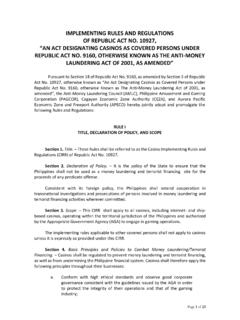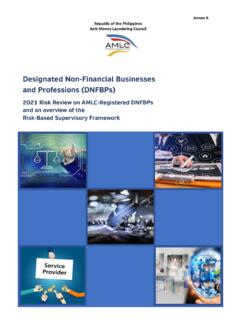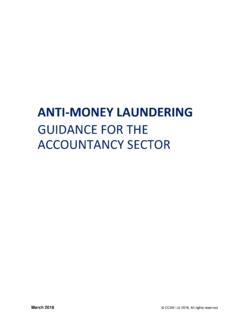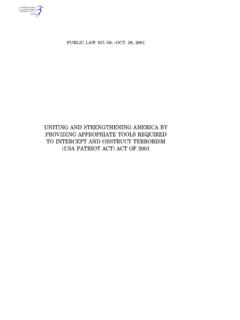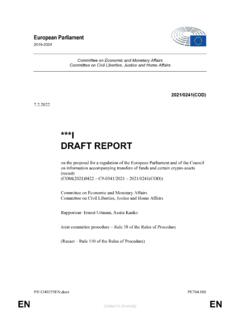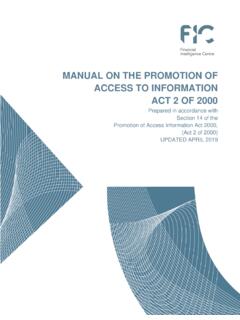Transcription of TERRORISM AND TERRORISM FINANCING RISK …
1 EXECUTIVE SUMMARY anti - money laundering COUNCIL 2021 Image by mohammed Hassan from Pixabay ( ) Image from ( ) Image from ( ) 1 Caveat This risk assessment is an update to the Second National Risk Assessment (NRA), specifically on the understanding and assessment of TERRORISM and TERRORISM FINANCING (TF) risks in the Philippines. It also intends to determine the direction of risks based on the emerging and current issues as well as significant developments and progress done domestically and internationally, relative to the combating TERRORISM and its FINANCING . The risk assessment uses both quantitative and qualitative approaches in gauging associated risks relative to TF and TERRORISM .
2 Data and information are sourced from transaction reports submitted to anti - money laundering Council (AMLC); statistics and information provided by law enforcement and intelligence agencies; and published articles and studies. The document also serves as a guidance paper for financial institutions (FIs) and law enforcement agencies (LEAs), specifically as regards their risk-based strategies. Suspicious financial indicators and triggers as well as case typologies presented in this study may aid in the identification, detection, and investigation of possible financial transactions linked to TERRORISM and TF. Lastly, the document presents existing challenges that FIs, LEAs, and supervisory agencies are facing, relative to the identification and investigation of the money trail associated with TERRORISM and TF.
3 2 EXECUTIVE SUMMARY The Mutual Evaluation Report (MER), which was adopted by the Asia/Pacific Group on money laundering (APG)1 in August 2019, identified certain deficiencies on the assessment of threats posed by the presence and movement of foreign terrorist fighters (FTFs) in the Philippines, as well as the mixed understanding of TERRORISM and TF risks across all sectors. One of the noted deficiencies in the MER is on the implementation of TF-related targeted financial sanctions (TFS), which is a concern for various covered persons (CPs).2 Also, the MER stated the lack of false positive freezing actions among FIs, relative to transactions associated with TF.
4 The 2019 MER further recommended that the Philippines must continuously update assessments on TF risks to enhance the understanding of emerging typologies of TF in the country, noting the following essential items: 1. TERRORISM and TF cases and related events; 2. Role of FTFs as regards the activities relative to TERRORISM in the country; 3. Impact of Philippines government/military responses to TF networks; and 4. Changes in the threat environment, particularly to TERRORISM and TF. The Philippines, in its commitment to combat TERRORISM and its FINANCING , responded to the need to establish a comprehensive legal framework for the implementation of United Nations Security Council Resolution (UNSCR) 1373 ex parte through the anti - TERRORISM Act of 2020 (ATA) in July 2020.
5 This further strengthens the legal framework, alongside Republic Act No. 10168 or the TERRORISM FINANCING Prevention and Suppression Act of 2012 (TFPSA). The study, which is undertaken by the AMLC, with the support of the National AML/CFT Coordinating Committee TERRORISM FINANCING /Proliferation FINANCING Subcommittee (NACC-TFPFSC), utilizes the standard risk framework and the guidance of the Financial Action Task Force (FATF) on TF risk assessment. The estimates of likelihood are based on a combined assessment of the threat and vulnerability of a channel to TF activity. The assessments and rating are purely based on qualitative and descriptive approaches and are based on major documents published: (1) 2017 NRA of the Philippines; (2) Third MER of the Philippines; (3) 2017 to 2019 Reports of the National Police Organization for the Association of South East Asian Nations (ASEANAPOL); (4) various AMLC studies and strategic reports; and (5) various published documents by the FATF and the APG.
6 1 The Asia/Pacific Group on money laundering is an inter-governmental organization, consisting of 41 member jurisdictions, focused on ensuring that its members effectively implement the international standards against money laundering , TERRORISM FINANCING , and proliferation FINANCING related to weapons of mass destruction. 2 Covered persons, as defined under Republic Act No. 9160 or the anti - money laundering Act of 2001, as amended 3 SUMMARY OF FINDINGS The existence of TERRORISM and TF threats is evident in the suspicious transaction report (STR) submissions by CPs. Exponential increase can be observed from 524 STRs in 2018 to 7,230 STRs in 2020.
7 The monthly trend shows a surge in STRs from September to December 2020, months after the enactment of the ATA. *Data as of 29 December 2020; expected increases in the succeeding database extraction Filing of STRs is expected to further increase following the designations of local threat groups as domestic terrorists in December 2020. STRs are reported through coordination between the AMLC and CPs for the possible nexus between the accounts and TERRORISM and TF. Further, the increase in trend can be attributed to the increasing awareness of CPs in detecting and determining possible financial transactions that may be associated with TF.
8 Other contributory factors include the regular update of risk understanding through the engagement of the AMLC and other LEAs with CPs and industry associations; the existence of a public-private partnership between the AMLC and CPs; and the continuous coordinated efforts of various agencies in anti - money laundering and counter- TERRORISM FINANCING (AML/CTF) campaigns. Noticeably, majority of the STRs are below PhP5,000 (USD100 and below), explaining one of the red-flag indicators associated with TF, that is, structured or small amounts of frequent transactions that with no specific patterns. *Excluded STRs that used the generic code [ZSTR code] 46%11%17%2%19%2%3%Range of Values of TERRORISM and TF-Related STRs, 2018-2020aP5,000 and belowBetween P5,001 - P10,000 Between P10,001 - P50,000 Between P50,001 - P100,000 Between P100,001 - P500,000 Between P500,000 - P1,000,000 Over P1,000,000201820192020V O L U M E O F T E R R O R I S M A N D T F-R E L A T E D S T R S05001000150020002500 JanFebMarAprMayJunJulAugSepOctNovDecTerr orism and TF-related STRs, 2018-2020201820192020 4 There is, however, an increase in the STR value within the transaction ranges of PhP10,001 to PhP50,000 and PhP100,001 to PhP500,000, particularly in 2020.
9 Cash and remittance transactions are commonly used to move and to transfer funds associated with TERRORISM and TF. From the sample TERRORISM - and TF-related STRs, it is estimated that PhP304 million are cash-related transactions, which is about 20% of the total value of the suspicious transactions. PhP263 million out of the PhP304 million, which is at 87%, are cash deposits, while only PhP39 million have been withdrawn via automated teller machines (ATMs) or over the counter. International and domestic remittances have also been reported as delivery channels to move or transfer funds. Remittance transactions account for 49% of the sample TERRORISM - and TF-related STRs.
10 Notably, based on STRs, the Philippines appears as a recipient of TF-related proceeds from other jurisdictions as the international remittances account for 91% of the total remittance-related STRs. This further supports the finding that the Philippines is a destination country as regards TF, due to the comparative high volume of international inward versus outward remittances. The volume of withdrawals/outward remittances or inter-account transfers could not account for the value of inward remittance transactions associated with TERRORISM and TF. Thus, this presumes that there are undetected disbursements, withdrawals, or transfer transactions associated with TF funds.


